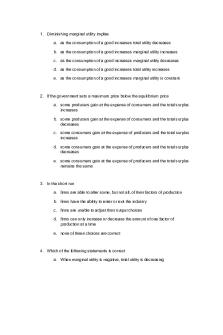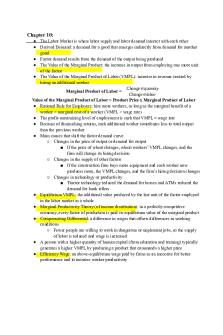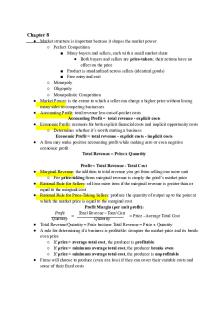Micro Econ Chapter 5 Lecture Notes PDF

| Title | Micro Econ Chapter 5 Lecture Notes |
|---|---|
| Course | Intro To Microeconomics |
| Institution | Indiana University - Purdue University Indianapolis |
| Pages | 3 |
| File Size | 173.1 KB |
| File Type | |
| Total Downloads | 70 |
| Total Views | 267 |
Summary
Chapter 5● Progressive Tax: takes a larger share of the income of high-income taxpayers than that of low-income taxpayers ● Regressive Tax: takes a smaller share of the income of high-income taxpayers than that of low-income taxpayers ● Excise Tax: tax charged on each unit of good or service that is...
Description
Chapter 5 ● Progressive Tax: takes a larger share of the income of high-income taxpayers than that of low-income taxpayers ● Regressive Tax: takes a smaller share of the income of high-income taxpayers than that of low-income taxpayers ● Excise Tax: tax charged on each unit of good or service that is sold ● Statutory Burden: describes the burden being assigned by the government; the responsibility of sending a tax payment ● Economic Burden: describes the burden created by the change in the after-tax prices faced by buyers and sellers ● Tax Incidence: a measure of who really pays it (division of the economic burden of a tax between buyers and sellers) ● Tax on Sellers shifts the supply curve to the left to reflect the new, higher marginal costs ○ Leads to decline in quantity sold ○ Increases the price that buyers pay and decreases the price that sellers receive ● Tax on Buyers shifts the demand curve to the left to reflect the lower willingness to pay for the good in the presence of a tax ○ Leads to a decline in the quantity sold ○ Increases the price buyers pay and decreases the price that sellers receive ● Whether the new tax is levied on buyers or sellers, it has the same economic effect
● Price incidence depends on the price elasticity of demand and supply ○ Sellers bear a smaller share of the economic burden when supply is relatively elastic - they can produce something else instead ○ Buyers bear a smaller share of the economic burden when demand is relatively elastic - they can buy something else instead ● When tax is imposed, quantity falls
● When the price elasticity of demand is low and the price elasticity of supply is high, the burden of an excise tax falls mainly on consumers ● When the price elasticity of demand is high and the price elasticity of supply is low, the burden falls mainly on producers ● Three Steps for Evaluating Taxes ○ Is the supply or demand curve shifting? ■ Any change affecting buyers or their MBs will shift the demand curve ■ Any change affecting sellers or their MCs will shift the supply curve ○ Is the shift an increase or decrease in taxes? ■ An increase (decrease) in taxes will shift the curve to the left (right) ○ How will prices and quantities change in the new equilibrium? ■ There will be two post-tax prices: one for buyers and one for sellers ● The cost of a tax is the inefficiency (deadweight loss) created because tax prevents mutually beneficial transactions from occurring ○ The size of the deadweight loss depends on the price elasticities of demand or supply ○ If you want to minimize the inefficiency costs of taxation, you should choose to tax only those goods for which demand or supply, or both, is relatively inelastic
● Price Ceiling: a maximum price that sellers can charge ○ Usually set below equilibrium ○ Pushes the price of a good down and fewer sellers want to sell ● Price Floor: a minimum price that sellers can charge ○ Usually set above the equilibrium ○ Pushes the price of a good up and fewer buyers want to buy
● Binding Price Ceiling: prevents the market from reaching the market equilibrium price ○ The highest price sellers can charge is set below the equilibrium price ○ Quantity demanded > quantity supplied ○ Price ceilings lower prices but cause shortages ● Binding Price Floor: prevents that market from reaching equilibrium price ○ The lowest price that sellers can charge is above the equilibrium price ○ quantity demanded < quantity supplied ○ Price floors raise prices and lower the quantity sold but cause surplus ● Quantity Regulation: minimum or maximum quantity that can be sold ● Mandate: a requirement to buy or sell and minimum amount of a good ● Quota: a limit on the maximum quantity of a good that can be sold ○ The government receives revenue with tariffs, but the importer receives the added revenue with quotas...
Similar Free PDFs

Econ 327 ch 5 - Lecture notes 5
- 4 Pages

Micro #2 - Lecture notes
- 19 Pages

Chapter 5 - Lecture notes 5
- 15 Pages

Chapter-5 - Lecture notes 5
- 6 Pages

Chapter 5 - Lecture notes 5
- 83 Pages

Chapter 5 - Lecture notes 5
- 4 Pages
Popular Institutions
- Tinajero National High School - Annex
- Politeknik Caltex Riau
- Yokohama City University
- SGT University
- University of Al-Qadisiyah
- Divine Word College of Vigan
- Techniek College Rotterdam
- Universidade de Santiago
- Universiti Teknologi MARA Cawangan Johor Kampus Pasir Gudang
- Poltekkes Kemenkes Yogyakarta
- Baguio City National High School
- Colegio san marcos
- preparatoria uno
- Centro de Bachillerato Tecnológico Industrial y de Servicios No. 107
- Dalian Maritime University
- Quang Trung Secondary School
- Colegio Tecnológico en Informática
- Corporación Regional de Educación Superior
- Grupo CEDVA
- Dar Al Uloom University
- Centro de Estudios Preuniversitarios de la Universidad Nacional de Ingeniería
- 上智大学
- Aakash International School, Nuna Majara
- San Felipe Neri Catholic School
- Kang Chiao International School - New Taipei City
- Misamis Occidental National High School
- Institución Educativa Escuela Normal Juan Ladrilleros
- Kolehiyo ng Pantukan
- Batanes State College
- Instituto Continental
- Sekolah Menengah Kejuruan Kesehatan Kaltara (Tarakan)
- Colegio de La Inmaculada Concepcion - Cebu









